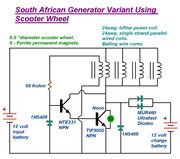Hi Jules,
Thanks for adding the arrangement number to your chart, it helps me see what your doing better. I agree with Gary on your set up. Now if it were me I would pick arrangement 2 or 4 and work on dialing it in real good so I had a good starting point for development. I would also recommend discharging C1, C2, C3 some to get a more realistic view of the charging capability of your circuit. In the last tests you were working with the top end of your batteries charge curve where the curve is much shallower. Now have some fun with it.
Michael
Thanks for adding the arrangement number to your chart, it helps me see what your doing better. I agree with Gary on your set up. Now if it were me I would pick arrangement 2 or 4 and work on dialing it in real good so I had a good starting point for development. I would also recommend discharging C1, C2, C3 some to get a more realistic view of the charging capability of your circuit. In the last tests you were working with the top end of your batteries charge curve where the curve is much shallower. Now have some fun with it.
Michael





Comment